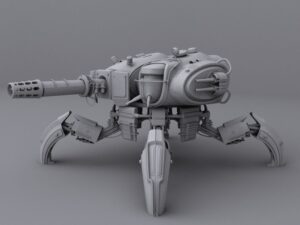Combat robotics has gained significant popularity in recent years, captivating enthusiasts from all walks of life. Building and competing with combat robotic kits is a thrilling and engaging hobby that combines engineering, creativity, and strategy. In this blog, we will delve into the world of combat robotic kits, discussing their components, types, and the immense satisfaction that comes with constructing your own mechanical gladiator. So, gear up, grab your toolkit, and let’s embark on an exciting journey through the realm of combat robotics!
- The Essence of Combat Robotic Kits: Combat robotic kits are specially designed packages that contain all the necessary components to construct a formidable fighting machine. These kits cater to both beginners and experienced builders, offering an opportunity to delve into the fascinating world of robotics without requiring advanced engineering knowledge.
Typically, combat robotic kits comprise various components, including a chassis, motors, wheels, weapons, and control systems. The chassis acts as the framework, providing structural integrity to the robot. Motors and wheels determine the robot’s mobility, while weapons such as spinning discs, hammers, or flippers are responsible for its offensive capabilities. The control system, which usually consists of a microcontroller and remote transmitter, enables the operator to maneuver the robot during combat.

- Types of Combat Robotic Kits: Combat robotic kits come in different forms, each with its own unique characteristics and combat strategies. Let’s explore some of the most popular types:
a) Wedge Robots: Wedge robots focus on defense and strategic maneuvers. They feature a low, sloping wedge-shaped front that allows them to get underneath opponents and flip or push them out of the arena.
b) Spinner Robots: Spinner robots derive their power from spinning weapons, such as vertical or horizontal discs, bars, or drums. The kinetic energy generated by these weapons can cause significant damage to opponents upon impact.
c) Hammer Robots: Hammer robots employ a powerful hammer or axe mechanism to deliver crushing blows onto opponents. The precision and timing required to land effective strikes make them an exciting choice for builders.
d) Flipper Robots: Flipper robots utilize a flipping arm or pneumatic system to launch opponents into the air, aiming to either immobilize them or throw them out of the arena. Precision and timing are crucial in successfully executing effective flips.
e) Cluster Bots: Cluster bots consist of multiple smaller robots, working together as a team. This type of robot brings a unique strategic advantage, as they can attack opponents from different angles simultaneously.
- Building Your Combat Robot: Building a combat robot from a kit is an immensely rewarding experience. Here are the essential steps involved in constructing your mechanical gladiator:
a) Research and Planning: Before diving into construction, familiarize yourself with the rules and regulations of combat robotics competitions. This will help you understand the weight limits, weapon restrictions, and other guidelines specific to the competition you plan to participate in.
b) Kit Selection: Choose a combat robotic kit that aligns with your interests and skill level. Consider factors such as the type of robot, complexity of assembly, and available support or documentation.
c) Assembly: Follow the provided instructions carefully, step by step, to assemble the chassis, attach the motors, wheels, and weapons, and integrate the control system. Pay close attention to details such as wiring, alignment, and balance.
d) Testing and Refinement: Once your combat robot is assembled, test its functionality and performance in a controlled environment. Identify any issues, such as weak spots, balance problems, or control glitches, and refine your design accordingly.
e) Strategy and Tactics: Developing effective strategies is essential in combat robotics



